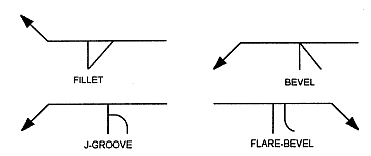

When this is shown on the right side of the symbol and it is called as the length of segment a hyphen and then the pitch of the welds. When using an intermittent weld there is a call out specified for the length of the weld and also the pitch that is to be applied. They are commonly referred to as skip welds in the industry.

This means that there are gaps between the termination of one weld and the start of the next. When a weld is not required to be continuous it is common to apply an intermittent weld. If this happens it will be called out using multiple arrows off of one reference line. There are instances when a weld may change direction because of part geometry. Hatching lines may be used to indicate the length of a weld instead of using a dimension on the weld symbol itself. There may be times where a length is given on a part and the location of the weld will be given with a dimension in order to achieve the correct location. This shows a 6” fillet weld to be applied to the arrow side. The weld length will be provided on the right side of the fillet weld symbol. This must be shown in the weld symbol to communicate the information between individuals. A weld may be applied only to a specific length of a joint. Whether the part is 2” or 60” long if it has no dimension the weld will run the length of the joint. If the weld does not have a dimension the weld will be the continuous length of the joint. In the case of the length of a weld, this may or may not have a dimension associated with it. This is common when fillet welds will all be the same size. Sometimes fillet welds will not be shown with a size but will rather have a note in the tail of the symbol that gives required information for size. If there were no indication of which leg is which the part could be welded incorrectly. This may include only one of the two leg lengths. In this situation the part must be dimensioned in order to apply the correct leg size to the right member being welded. There are times when an unequal leg fillet weld is called out. If a double fillet weld is called out the size will be shown for both sides of the joint, depending on the part these welds could vary in size so it is necessary to provide this information.

If it is an equal leg fillet weld it is not common to dimension it on the print as shown below for demonstration purpose.

If a single size is called out this is specifying that weld should have equal leg sizes. The size is indicating the leg length of the weld. This size is called out on the left side of the symbol before the vertical side. The vertical leg of the symbol will always be placed to the left regardless of which way the arrow is pointing.įillet welds may have a size associated with them. These welds can be applied on varying angles but this would be the most prominent.Ī fillet weld symbol can be used with an arrow side (below reference line) other side (above reference line) significance or on both sides (both sides of the reference line.) When a fillet weld is required on both sides of the reference line it is called a double fillet weld. This weld is used when the joint has two members coming together to form an intersection of commonly 90 degrees. Fillet welds are one of the most common weld types in the industry.


 0 kommentar(er)
0 kommentar(er)
